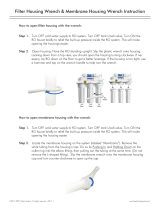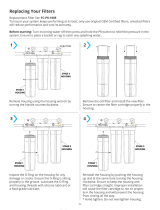
Please keep this owner’s manual for future reference.
It includes the information on how to properly operate and maintain your
iSpring Reverse Osmosis water filtration system.
TABLE OF CONTENT
BEFORE INSTALLATION.....................................................................................................................2
Inspect the package...............................................................................................................................2
Recommended tools list........................................................................................................................2
Operating conditions.............................................................................................................................2
Components Identification....................................................................................................................3
Installation Tips........................................................................................................................................4
How to use Quick-Connect fitting........................................................................................................4
To connect: .......................................................................................................................................4
To disconnect:...................................................................................................................................4
How to use Compression fitting with brass Nut, Collar, and tube Insert.............................................5
How to drill a hole on sink or counter-top............................................................................................5
Installation Steps.......................................................................................................................................7
Step 1: Install Feed Water Adapter (AFW)..........................................................................................7
Step 2: Install Drinking Water Faucet..................................................................................................7
Step 3: Install Drain Saddle..................................................................................................................8
Step 4: Install the Vertical Filters: Stages 1, 2, and 3...........................................................................8
Step 5: Install Tank Shut-off Valve (TSV)...........................................................................................8
Step 6: Install Reverse Osmosis Membrane.........................................................................................9
Step 7: Tubing Hook up (model specific sub-steps are marked with * )..............................................9
Step 8: System Start Up (model specific sub-steps are marked with * )............................................10
SYSTEM MAINTENANCE..................................................................................................................12
Stages 1 – 3 pre-filters: Replace every 6 – 12 months, or sooner if water flow gets slow.................12
How to change in-housing cartridges in 1st – 3rd pre-filter stages....................................................12
Stage 4 RO membrane: Replace every 2 – 3 years or sooner if TDS level starts increasing.............13
How to change reverse osmosis membrane........................................................................................13
Stage 5 T33 fine carbon: Replace every 12 months...........................................................................13
How to change inline cartridges in 5th – 7th stages...........................................................................13
O-rings: Replace every 3 years or sooner if leak happens at O-ring..................................................13
Extra Installation.....................................................................................................................................14
UV Lamp (part# iSpring UVB11) and Ice maker kit (part# iSrping ICEK)......................................14




















